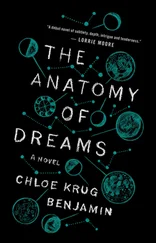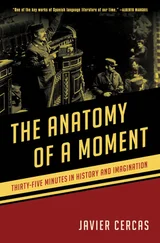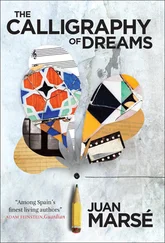He was perched on the edge, holding up to the light a locket my mother gave me. Usually I left it on my bedside table, but Thomas had hooked the chain around his index finger. The locket had been opened to reveal two photos: one of my mother, and one of me. He tapped the edge with his other index finger, so that it turned around and around, tangling on the chain.
When he saw me, he smiled, bright and sheepish.
“So sorry,” he said. “Didn’t mean to go out of bounds. I used the bathroom, and then I wandered in here. I sat down to have a look at the trains. Well, the place where trains would be. The empty trainless place.”
The locket was still on his finger. I held out my palm, and he gave it back to me.
“I tend to fidget,” he said. “I just picked it up to have something to do with my hands.”
“That’s all right,” I said, though I was spooked. I wanted to get him back downstairs, but he spoke before I could suggest it.
“You’re welcome to call me Thom.”
“All right.”
“If you like.”
“I’ll try.”
“All right,” he said, my words, and smiled.
The window by the bed was open; outside, a group of flies — the last survivors of the summer hatch — whined softly. Thom turned, swinging his legs around to face me instead of the train tracks.
“What do you really study?” he asked. “What within sleep?”
“Consciousness and REM cycles, like Gabe said. We make physiological recordings—”
“I remember what Gabe said.” He picked at the threading on my comforter for a moment, then dropped it down. “It just seemed a bit simplistic. First of all, there’s a word for what you’re studying. It’s lucidity, or lucid dreaming — when a person’s aware that they’re dreaming. Am I right?”
“That’s right.”
“Which is why I find it hard to believe that’s all you’re measuring,” said Thomas. “It’s been done. I learned about dreaming and lucidity in a couple of intro psych classes — long before you became involved in this kind of research, I presume. Some of the Romantics even knew about it: Thomas De Quincey, Coleridge, Keats.”
“You’re right — we’re not the first to study lucid dreaming. But we’re doing something different.”
I paused, and Thomas looked at me with expectation. I’m not sure when I made the decision to tell him more than I had ever told anyone else, but I know it was before that moment. Maybe it was when I followed him upstairs, leaving Gabe and Janna in the kitchen, or maybe it was even earlier — the first time I saw them, returning home in the storm.
“Accounts of lucid dreaming have been around since the fifth century,” I said. “Saint Augustine wrote about it first, and Tibetan Buddhists recorded their experiences in a funerary text. Back then, it was used to access a higher spiritual plane, even to relieve stress and problem-solve. It was treated like an escape. But we think of it as a return.”
“To?”
“To the self,” I said. “We dream in metaphors. If you’re having car troubles, you’re feeling powerless. Failing a test? You’re insecure, unprepared. Trapped? Well, that one’s obvious. The brain is like an excellent fiction writer: every part of a dream is laden with meaning that can be unlocked, analyzed, and understood. We hide our greatest hopes there, our deepest fears. And when we learn to read our dreams, so to speak — not retrospectively, when we wake up, but right there in the moment — we’re reading the story of who we really are.”
“Isn’t that just Freud?” asked Thom.
“Partly.” I sat down beside him, my palms beneath my thighs. “Freud’s ideas make up the bedrock of dream interpretation, so it’d be impossible for us to avoid his influence — not that we’re trying to. Freud was the first to suggest that dreams give us access to the unconscious mind; he called them the royal road, the king’s highway. Dreams are almost entirely visual, but he gave us a language with which to talk about them, and it still holds up. Analysis is essentially an act of translation.”
“You’re old-school, then,” said Thom. “These days, don’t most people believe that dreams are meaningless? The brain sloughing off nervous tension?”
“It’s true. Our ideas aren’t popular. But dreams involve a whole host of brain mechanisms — they’re as rich in neurological activity as many conscious processes. There’s just too much going on for us to explain them away as random nerve firings.”
Thom grinned. “Do you believe in Freud’s other ideas, too, then? The sexual complexes? The idea that all dreams are wish fulfillment?”
I shook my head. “That’s where we’re more aligned with Jung. He thought dreamers could tap into resources of creativity and ingenuity, imagination and adventure. Healing, too. Besides, Freud never studied lucid dreaming. He relied on dream recollection, which means his patients reported their dreams after they woke up. But memory is fallible — it’s what makes eyewitness accounts notoriously unreliable — and that means the conscious mind isn’t trustworthy. Lucid dreaming allows patients to experience their dreams in real time. It gives them a panoramic view.”
“A sense of narrative,” said Thom.
“Exactly. Lucid dreaming also vastly improves dream recall, which means patients can work through their issues in the moment — and come away with a more thorough memory of what happened. It isn’t enough to go cherry-picking for symbols. Freud looked for the metaphors, but he didn’t string them together. He didn’t look for the full story.”
It was difficult to breathe. But if Thomas was starting to judge me, he didn’t show it; when he spoke, his tone was light.
“And why would anyone want to do all that work while they’re dreaming? Isn’t sleep supposed to be restorative?”
I laughed.
“Our patients don’t have a choice,” I said. “The people who come to us have sleep disorders — disorders that make them talk in their sleep and get out of bed.”
Thomas crossed his legs. I could see a childlike interest in him that made me think of what he must have been like as a boy — the floppy reddish hair, the round glasses, the long limbs in miniature.
“Still,” he said. “Why do you have to interfere in their dreams? You can’t send ’em to therapy while they’re awake?”
“These aren’t your garden-variety sleep issues — sleep apnea, insomnia. The patients we see have disorders like somnambulism and RBD — that’s sleepwalking and REM behavior disorder, parasomnias that make them act out their dreams. Most of us are physically paralyzed during REM sleep, but these patients aren’t, and there’s nothing more dangerous than a dreamer out of bed. They can attack their bedmates, trying to fight off intruders who aren’t there. Some have even jumped out of windows. These people are disturbed at a subconscious level — and in order to help them, we have to meet them there. Lucidity enables them to realize they’re dreaming. It enables them to intervene.”
“So you’re hacking in.”
His face was pleasant enough, but his voice had a new edge.
“What do you mean?”
He leaned back on the bed, his elbows propped up behind him, and cocked his head.
“You’re intruders. Robbing the bank of the subconscious.”
“We’re breaking in, yes. But we’re helping them break in, too. We give patients the opportunity to see who they really are and how they came to be that way. It’s empowering.”
“To look at something is to change it,” said Thom. “Your patients have disorders — fair enough. But you’re still opening up a part of the brain that the brain itself has tried desperately to hide. There’s got to be an evolutionary reason we don’t remember most of our dreams. Some things are better tucked away, if you catch my drift. Some books shouldn’t be read.”
Читать дальше












